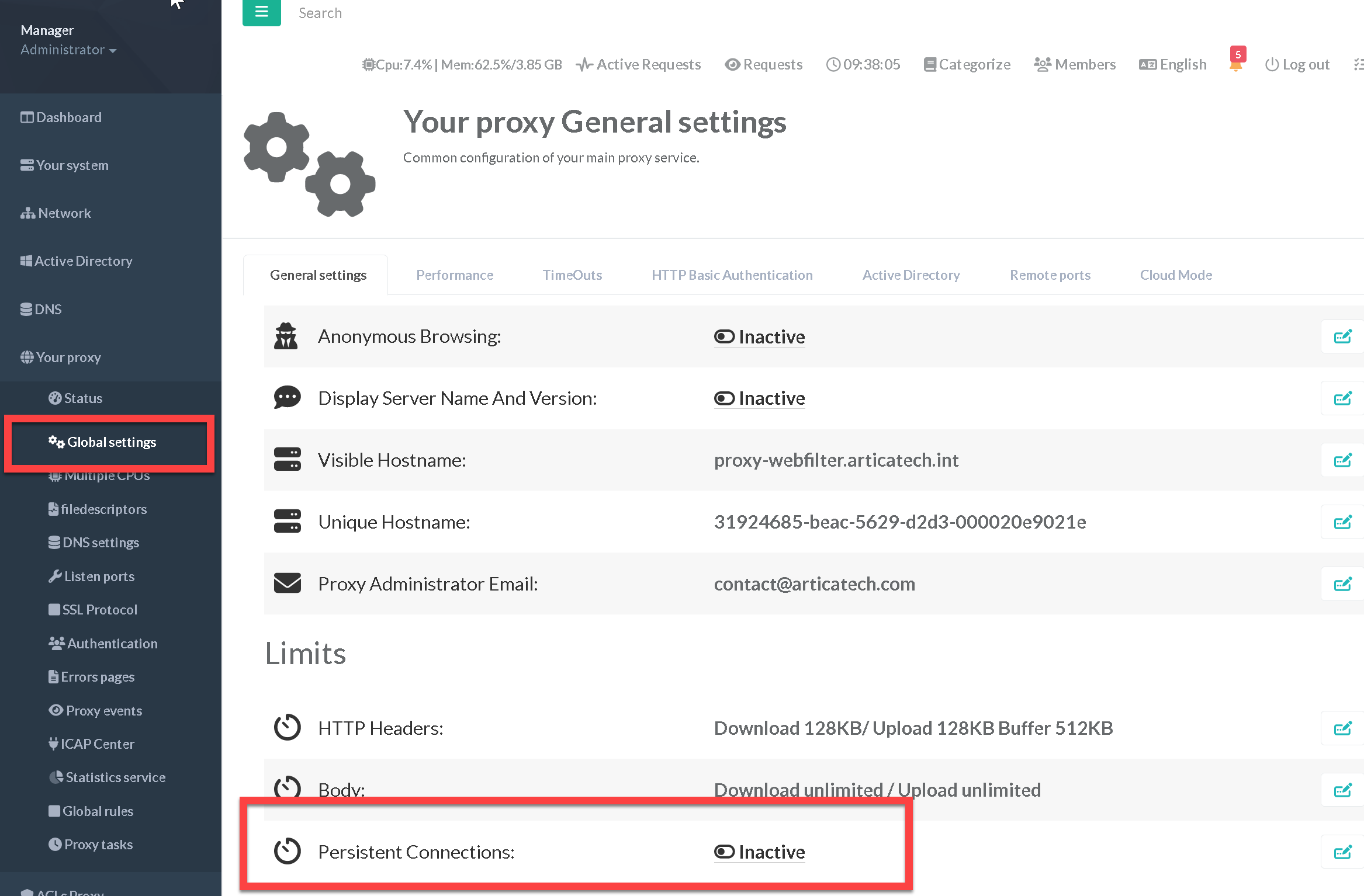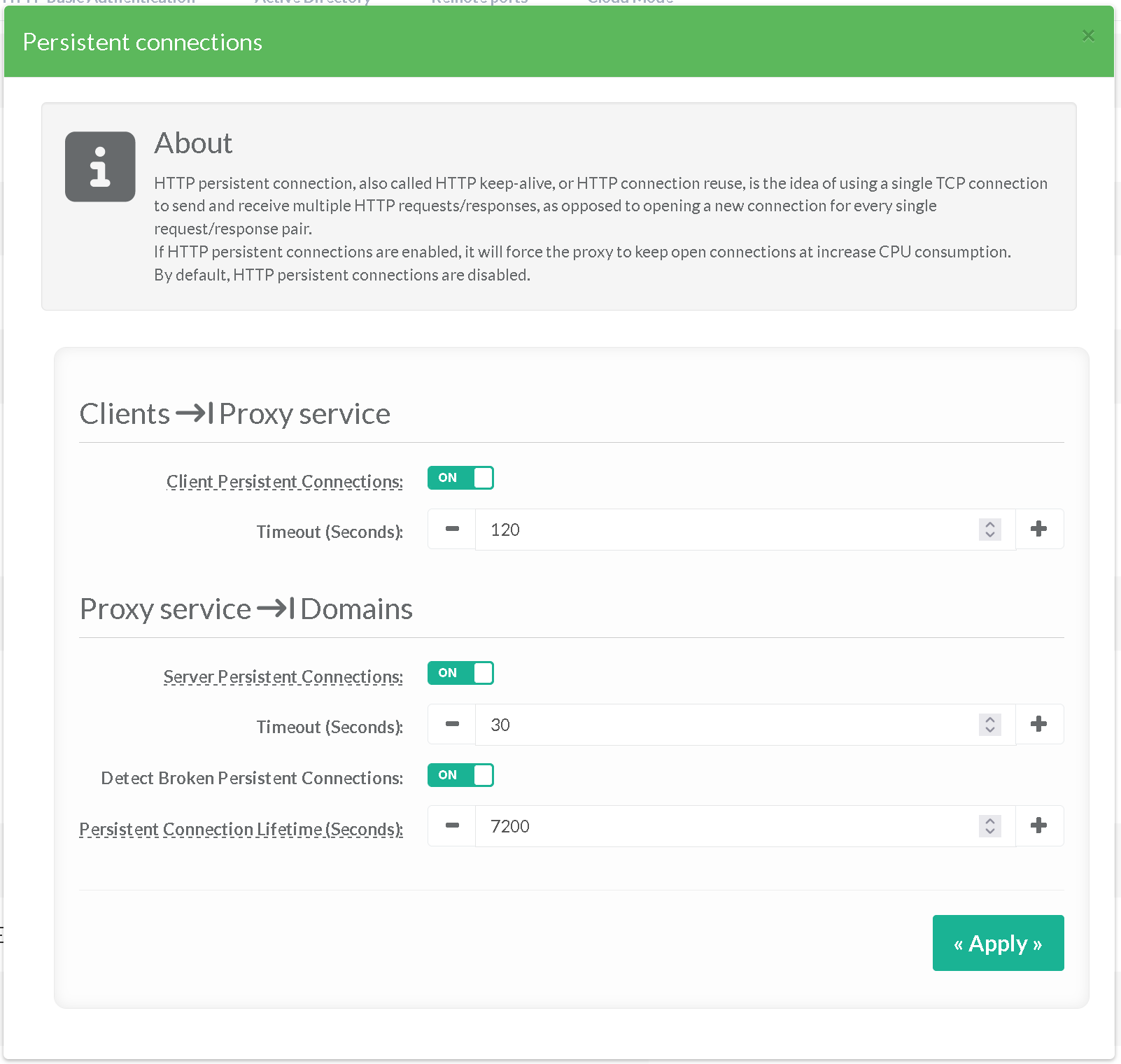By default, the use of persistent connections is disabled.
Using persistent connections can provide several benefits..
- Reduced latency:
Reusing the same TCP connection can reduce the time it takes to establish a new connection and perform the SSL/TLS handshake, leading to faster response times and reduced latency. - Increased throughput:
Since persistent connections eliminate the need to establish a new TCP connection for each request, they can increase the overall throughput. - Improved performance:
By reducing the number of TCP connections, persistent connections can reduce the load on the Proxy service and improve its overall performance. - Reduced network overhead:
Since persistent connections reuse the same TCP connection, they can reduce the amount of network overhead associated with establishing new connections and managing multiple connections.
Overall, using persistent connections can provide several performance benefits, particularly in scenarios where clients frequently request multiple objects from the same server such as Office365, Web sockets…
However, it's important to note that this behavior may not always provide performance benefits and may require careful configuration and monitoring to ensure optimal performance.
This method does have one drawback, however.
It will increase the memory usage of the proxy service to around 36MB per user.
If your proxy manages around 500 users, you can expect to consume 18Gb of memory on the proxy service (i.e. a whole system with at least 22Gb of memory).
The configuration allows to manage persistent connections for two behaviors.
The use of persistent connections from browsers to the proxy service and from the proxy server to the web servers.
- On Your
Proxy>Global Settings, click on the “Persistent connections” link.

The form provide 2 sections

¶ Client persistent connections
The use of persistent connections from browsers to the proxy service refer to the ability of the client to reuse the same TCP connection to communicate with the Proxy service for multiple requests instead of establishing a new connection for every request.
¶ The timeout value
The timeout field controls the maximum amount of time that a client persistent connection can remain idle before the Proxy service closes the connection.
When a client persistent connection is idle for longer than this parameter, the proxy service will close the connection to free up resources and avoid potential issues with stale connections.
This timeout helps to prevent resources from being tied up by idle connections and can help to improve the overall performance of the Proxy service.
The default value is 120 seconds (2 minutes), but it can be adjusted based on the specific needs and characteristics of the Proxy deployment.
It's worth noting that setting the client timeout too low can result in a higher rate of connection setup and teardown, which can degrade performance.
On the other hand, setting it too high can result in the potential for idle connections to consume resources unnecessarily. Therefore, it's important to carefully consider the appropriate value for the timeout based on the specific deployment and usage patterns.
¶ Server persistent connections
Refer to the ability of the Proxy service to reuse the same TCP connection to communicate with the origin server (Web servers or Parent Proxies) for multiple requests instead of establishing a new connection for every request.
¶ The timeout value
Controls the maximum amount of time that a persistent connection can remain idle before Proxy service closes the connection.
When a server persistent connection is idle for longer than the server idle persistent connection timeout, Proxy service will close the connection to free up resources and avoid potential issues with stale connections.
This timeout helps to prevent resources from being tied up by idle connections and can help to improve the overall performance.
The default value is 30 seconds, but it can be adjusted based on the specific needs and characteristics of the Proxy deployment.
¶ Detect broken persistent connections
Enables Proxy service to detect and close persistent connections that are no longer functional due to network errors, server timeouts, or other issues.
When enabled, the proxy service will periodically send a small amount of data (every 10 seconds ) through each persistent connection to verify that the connection is still active and functional.
If the connection is no longer functional, the proxy service will close the connection and establish a new one for the next request.
¶ Persistent Connection Lifetime
Refers to the maximum lifetime of a persistent connection (also known as a keep-alive connection) to a backend server.
When a client makes a request to Proxy service for a resource, it may keep the connection to the backend server open after delivering the requested resource.
This is done to improve performance and reduce the overhead of establishing a new connection for subsequent requests. This parameter determines how long the proxy service will keep the connection to the backend server open before closing it.
The default value is 2 hours (7200 seconds). However, this value can be adjusted to suit the needs of the specific deployment.
Setting too high may result in resources being held by idle connections for too long, leading to resource starvation for other clients.
On the other hand, setting too low may result in frequent connection establishment overhead, reducing performance.